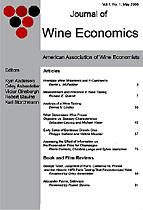|
Even in the rarefied air that wafts through the groves of academe, economists often lack for respect. Their field of inquiry is jokingly called "the dismal science," and amid the joy of graduation, postgrad economics majors line up wearing dull gray academic hoods identified as "drab." But lately there've been signs of a heartbeat beneath those monochromatic vestments. From cameo appearances in the gossip columns by the longtime Federal Reserve chief Alan Greenspan to the breakout best-seller list appearance of "rogue economist" Steven D. Levitt's intriguing book Freakonomics, economists are suddenly becoming hot properties. So it was clearly only a matter of time before someone came up with the idea of viewing the world of wine through an economist's lens: Put your hands together and welcome the Journal of Wine Economics, a thick and admirably scholarly periodical published by the newborn American Association of Wine Economists, a consortium of five economic academics who also happen to be wine geeks in the finest sense of the word.
Make no mistake, The Journal of Wine Economics is a scholarly journal. dense with facts, figures and formulas. Without a strong background in statistics, chances are most non-economist readers will skim the more austerely mathematical bits. But there's a lot to skim, and even casual browsing turns up all manner of interesting nuggets and factoids. The first edition contains six deep articles, and for dessert, a math-free movie review (Alexander Payne's Sideways, reviewed by Stavins) and book review (George Taber's Judgement of Paris: California vs. France and the Historic 1976 Paris Tasting That Revolutionized Wine, reviewed by Ashenfelter, who compares Taber's analysis with his own study of the Paris tasting). It opens with an examination of "Interstate Wine Shipments and E-Commerce" by Prof. Daniel L. McFadden of the University of California at Berkeley, which concludes with a free-the-grapes call for the U.S. Federal Trade Commission to deter attacks on interstate commerce by "concentrated economic interests" when such attacks deprive consumers of the benefits of a free and competitive market. The graphs, tables and formulas start to appear in Princeton Prof. Richard E. Quandt's paper, "Measurement and Inference in Wine Tasting," a lengthy study of the difficulties inherent in ranking evaluations by a group of judges in blind tasting. In "Analysis of a Wine Tasting," Emeritus Prof. Dennis V. Lindley of University College London pursues an in-depth, statistical analysis of the judges' scoring at the famous 1976 California-vs.-France tasting in Paris, and reaches a much more nuanced conclusion than the conventional wisdom that "California won." In another intriguing if math-dense analysis, colleagues Sébastien Lecocq and Michael Visser of Institut National de la Recherche Agronomique (INRA) in Paris conduct a thorough study of the relative impact of sensory characteristics (judgment of the wine by expert tasters) and objective characteristics (appellation, varietal and related information) on wine market prices. Their perhaps surprising conclusion: "Characteristics that are directly revealed to the consumer upon inspection of the bottle and its label (ranking, vintage and appellation) explain the major part of price differences. Sensory variables to not appear to play an important role." Rounding out the first issue are two reports on more variables that influence wine pricing: "Early Sales of Bordeaux Grands Crus" by Philippe Mahenc of INRA and Valérie Meunier of the University of Aarhus in Denmark; and "Assessing the Effect of Information on the Reservation Price for Champagne" by Pierre Combris (INRA), Christine Lange (Centre Européen des Sciences du Goût in Dijon) and Sylvie Issanchou (INRA). If your preferences go more in the direction of light beach reading about wine (and there's no shame in that), or if you'd rather drink wine than read about it, it's not likely that the Journal of Wine Economics is for you. But I spent a surprising amount of time with my copy, even if I did speed-read past the formulas. I think serious wine "geeks" will love this publication, even if we're not economists. A subscription to the Journal of Wine Economics, which contains no advertising, is included with membership in the American Association of Wine Economists. Individual membership is $39 per year in the U.S., $45 to cover postage for members elsewhere. Institutional membership (incl. libraries) is $100 annually.
For more information about the journal and how to join The American Association of Wine Economists, visit the Association's Website,
TALK ABOUT WINE ONLINE:
Today's article is cross-posted in our Netscape WineLovers Community, where we also welcome comments and questions. To contact me by E-mail, write wine@wineloverspage.com. I'll respond personally to the extent that time and volume permit.
PRINT OUT TODAY'S ARTICLE  Winebuys.com: Irresistible Deals On Our Latest Arrivals
Your first order SHIPS FedEx for FREE!
Save 31%!
Shop New Arrivals
Browse Wine Under $15
Shop All Wines
• All wines always up to 50% off
SUBSCRIBE: Administrivia To subscribe or unsubscribe from The 30 Second Wine Advisor, change your E-mail address, or for any other administrative matters, please use the individualized hotlink found at the end of your E-mail edition. If this is not practical, contact me by E-mail at wine@wineloverspage.com, including the exact E-mail address that you used when you subscribed, so I can find your record. We do not use our E-mail list for any other purpose and will never give or sell your name or E-mail address to anyone. I welcome feedback, suggestions, and ideas for future columns. To contact me, please send E-mail to wine@wineloverspage.com All the wine-tasting reports posted here are consumer-oriented. In order to maintain objectivity and avoid conflicts of interest, I purchase all the wines I rate at my own expense in retail stores and accept no samples, gifts or other gratuities from the wine industry.
Wednesday, July 5, 2006
|





